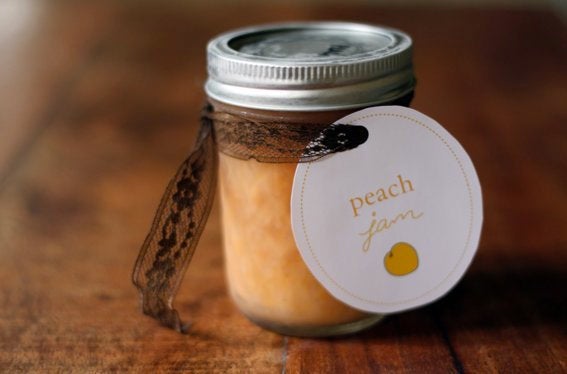
If you have any experience canning fruit, you've probably heard the line that you need, need, need white sugar in your jam if you don't want it to go bad. And not just a little sugar. A lot. Those of us who avoid refined sugar often feel a tinge of guilt as we stir in pound after pound into our beautiful fruit; we know it's bad for us, but we want to save this fruit for colder months. So we suck it up and accept the sugar as a necessary evil.
What if I were to tell you that there was a way to put up fruit without refined sugar? Without Splenda? With only fruit juice? You might tell me I was crazy, and a few weeks ago I'd have agreed with you. And then I met Jen Cordaro, the magical jam-maker at Jenny's Jars. She shared with me some of her refined-sugar-free jam, and it was one of the best things I've tried in a while. I was hooked.
I was also a little unsure of the science behind making jam without white sugar, but it turns out it's actually true. Below you'll find all the tips you need in an interview with Jen, and then her recipe for her All-Natural Spiced Vanilla Pear Jam. It's a revelation, really. I was impressed.
When making jam without refined sugar, how can you be sure it won't grow bacteria?
Well, you can never be 100 percent sure. But, the best way to prevent bacteria growth is to make sure you're using the proper Ph-levels in your recipes and that you are processing your jars correctly, in rapidly boiling water for the right amount of time. This kills yucky things like botulism, which grows in anaerobic conditions -- the perfect environment produced by canning. Acids are the only safe items to can in a water bath. To boost the acidity in most recipes, one would find the common addition of lemon juice or vinegar in recipes.
Be aware: when adding vinegar, make sure the acidity level is listed at five percent or higher on the label. Sugar is also a preservative and together with an acidic produce item and/or the addition of an acid like lemon, one can produce safe items. The best way to do that is to only use tested recipes from any agriculture extension at universities like UC Davis, from the USDA (which has an entire section on their website dedicated to canning), or from the Ball Blue Book. Once a basic understanding of the science behind canning is reached, some experimentation can happen.
Don't let all of this talk about bacteria scare you away from learning to can. It's very unlikely that anyone will get sick from what you make as long as you follow recipes exactly. Canning is simple once you get the basics down! And of course, do not eat anything that has been canned if the seal is broken, the top "pops" when pushed down on, if you open a jar and find mold growing, or a foul smell. When you open a new jar, it should smell exactly like what's inside of it.
- Practice, practice, practice! And write down what you did so you can either replicate it if it comes out right or find your mistake if it didn't.
- Remember, when making jams without refined sugar, it will not gel the same. Don't expect a hard-set jam. Rather, be excited about an all-natural fruit flavored spread that can do double time as a topping for ice cream or French toast, or a side dish!
- If you want your jam to gel, add no-sugar needed pectin. It still won't be like a traditional jam, but it will be pretty close. A little heavy on the pectin is better than too light, if you want a more traditional set.
What kinds of fruit make the best refined-sugar-free jam? Which fruits should be avoided?
The best and easiest to find recipes for are: apples, grapes, strawberries, peaches, pears, raspberry, blackberry, blueberry, or cherry.
Avoid: pumpkin -- it is not safe to can. I know everyone loves pumpkin butter, but it's better left in the refrigerator.
Can you talk a little about using Splenda for jam? How does it work?
Splenda works just like sugar! Cup for cup. Just make sure to use baking Splenda, not the kind in the little packets. Or, if you don't prefer the aftertaste of Splenda, you can use the no-sugar/low-sugar pectin and decrease the Splenda amount drastically. Just follow the normal directions and use Splenda for the sugar listed in a low-sugar recipe.
Do you have a favorite book or other resource for when it comes to making jam? What is it, and why?
My favorite book would be my self-made family recipe book, but of course that doesn't do much for others wanting to learn to can. In terms of a mainstream book, I'd recommend Put 'em Up! by Sherri Brooks Vinton or the famous Ball Blue Book. They're both great books that layout the fundamentals of food preserving. Each book also comes with a slew of recipes, some great, some not so great. But, part of the fun of canning is trial and error and experimenting in the kitchen to find what you like!
Here's the recipe for Jen's Juice-Sweetened Spiced Vanilla Pear Jam, an incredibly warm, comforting jam with no refined sugar.
Stephanie Stiavetti is a food writer and cookbook author living in San Francisco. Her food blog, The Culinary Life, is a repository for all things comfort food related, from savory dinners to transcendental desserts. You can also follow her on Facebook.